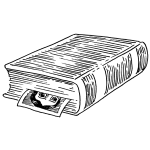You’re reading, reading a book, and when you’re not reading it, you mark your place. Maybe you simply use the book-jacket flap; if it’s a disposable book or you’re just a heathen, you fold the page corner down. But you usually mark the page with a foreign object, anything from a shred of newspaper to a strip of embossed leather someone bought you at Stonehenge. Often you don’t have much of a choice—because you also have a life outside of that reading, a life of rocket-launched inconvenience and impromptu upheaval, you often have to use whatever’s at hand to hold your space. Indeed, if you have children, then you know interruption like Priam knew Greeks hammering at his door for years and are usually rewarded for your endurance with an array of glitter-and-yarn craft-class bookmarks. But where are they now? You have to put that book down because the dog’s tongue is suddenly stuck to the freezer rack, or the urologist’s nurse has just called you in, or you’re suddenly at your stop and so will end up hustling off the train in a wad of shuffling commuters with only your finger inserted into the book’s crevice.
I wonder about a certain Freeport, Long Island, teacher who was apparently reading John Dos Passos’s Manhattan Transfer (in its first, 1925 Harper & Brothers hardcover) in March 1946, and who designated where he or she paused during the “Longlegged Jack of the Isthmus” chapter (in which, among other things, the threadbare writer struggles with his landlord and his yen for rye) with two items. The first was an onion-skin parental note, delicately written with a fountain pen and folded three times, addressed “To Whom It May Concern” and excusing a certain David Wolsk early from school, at 3 p.m. exactly, for the purposes of a dental appointment. The signature belongs to “(Mrs. S.) Celia G. Wolsk” of 71 New York Avenue, Freeport. The second, nestled in beside it, is a carefully ripped, four-square-inch crib sheet, penciled in minuscule longhand, for what appears to be a seventh-grade biology test (ectoderm, mesoderm, that sort of thing), and, you’d think, rescued from its larcenous test taker by the Dos Passos–reading prof in question. Was it in fact twelve-year-old David Wolsk’s test? Did he plan to defraud the exam and then light out before dismissal for the dentist’s? Or was it, instead, his book? That’s not such a far-fetched notion: teens read at a more sophisticated level sixty years ago (indeed, Latin was still on the docket), and Manhattan Transfer is Dos Passos’s most readable big splash of a book. Did David Wolsk simply show the note and then keep it, and...
You have reached your article limit
Sign up for a digital subscription and continue reading all new issues, plus our entire archives, for just $1.50/month.
Already a subscriber? Sign in





